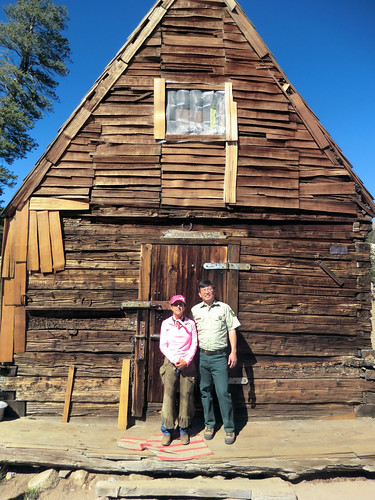Chinese Cultural History in the American West Put in Spotlight by Forest Service, Partners
Posted by Fred Wong, U.S. Forest Service, on April 7, 2016 at 11:00 AM
http://blogs.usda.gov/2016/04/07/chines ... -partners/
Current range permittee Lynn Sanguinetti and Fred Wong, U.S. Forest Service district ranger, stand in front of a cabin once used by Chinese cowboys in 1907. The cabin is on the Stanislaus National Forest. (U.S. Forest Service)
The often-forgotten footprints of Chinese immigrant laborers cover the floor of America’s national forests, railroads and mines. These laborers left behind physical and cultural remnants of the past woven into the fabric of our country.
The U.S. Forest Service is partnering with The Chinese American Historical Society and others to ensure the legacy of these early American immigrants is long remembered. The partnership is working on a website scheduled to launch in April 2016 that will highlight more than 50 Chinese heritage sites with self-guided tour information for destinations in California and Nevada. The partnership goal is to schedule guided tours during the summer of 2016 in both states.
“Traces of Chinese history, long forgotten by many, can be found within the present day boundary of the Stanislaus National Forest,” said Lisa DeHart, a Forest Service archaeologist in California. “Chinese laborers contributed to building portions of the Columbia and Stanislaus Miners Ditch, segments of the Westside Lumber Companies railroad grade and the Big Gap Flume.
“However, few people are aware that Chinese men also were cowboys, as evidenced by the Chinese names left behind on the wall of the 1875 Cooper Cabin, a high-elevation range cabin in the Emigrant Wilderness.”
The retelling of these stories is important because their existence during the mid- to late-1800s often solicited hatred. Newspaper articles focused more on describing Chinese as foreign threats to the American workforce and editorial cartoons were often racist.
In reality, many Chinese immigrants were driven from mining camps and eventually Chinatowns through intimidation, arson, violence and murder. Those who managed to survive were either returned to China or moved into larger cities.
But the evidence of their hard work and dedicated contributions remain scattered across the physical landscape, in documents deep in the recesses of local historical societies and in government records.
Through our research on the Stanislaus and other forests, we have found many interesting historical sites that highlight Chinese-American contributions to developing of the west. Those examples include what many would suspect: railroad tunnels, railroad and road grades, water ditches and tunnels, flumes, stone walls and corrals, battlefields, agriculture, wine cellars, lumber camps, mining camps, Chinatowns, businesses, temples, and more.
The wooden Big Gap suspension flume...
[ read more... ]
Chinese Sierra Nevada Cultural History in Spotlight
- ERIC
- Your Humble Host & Forums Administrator

- Posts: 3254
- Joined: Fri Oct 28, 2005 9:13 am
- Experience: Level 4 Explorer
- Location: between the 916 and 661
Chinese Sierra Nevada Cultural History in Spotlight
New members, please consider giving us an intro!
Follow us on Twitter @HighSierraTopix. Use hashtags #SIERRAPHILE #GotSierra? #GotMountains?
Follow us on Facebook: https://www.facebook.com/HighSierraTopix
Follow us on Twitter @HighSierraTopix. Use hashtags #SIERRAPHILE #GotSierra? #GotMountains?
Follow us on Facebook: https://www.facebook.com/HighSierraTopix
- old and slow
- Topix Acquainted
- Posts: 73
- Joined: Wed Jun 05, 2013 8:55 am
- Experience: Level 2 Backpacker
- Location: Monterey Bay
Re: Chinese Sierra Nevada Cultural History in Spotlight
Good article Eric. Thanks for sharing another bit of unknown/forgotten California history.
Who is online
Users browsing this forum: No registered users and 5 guests

